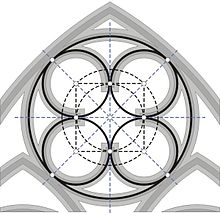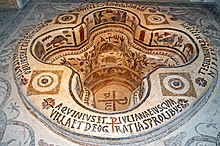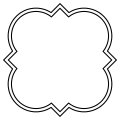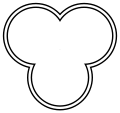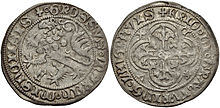Quatrefoil
The quatrefoil is a common ornament of the Romanesque and Gothic . It usually consists of four circular arcs with the same radii, which are inscribed in a circle. In architecture, quatrains were mainly used in tracery in the design of windows or (as glare tracery ) in the decoration of wall surfaces. The quatrefoil also appears as a floor plan of buildings or parts of buildings.
to form

There are both "standing" and "lying" forms. A quatrefoil has four axes of symmetry . There are two commonly used shapes: Most quatrains consist of either four semicircular arcs or four three-quarter circle or horseshoe arcs . In addition, there are numerous variants , especially in the late Gothic period , including elongated or curved quadrangles, whose surfaces or tracery lines can overlap - especially in the case of blind tracery (see picture on the right).
Lying quatrefoil with tips of a square
history
Four passes do not appear in classical antiquity. One of the first four passports from the 6th century can be found in the early Christian baptistery of the Tunisian city of Kelibia , which is now in the Bardo Museum in Tunis. It is repeated on a lower level and is completely covered with mosaics that possibly contain a four-season symbolism.
From the eighth century onwards, the interpretation of the quatrefoil was adopted from the Byzantine church by the Latin church and initially stood increasingly for the unity of the four evangelists . A well-known example is the depiction of Markus in the Carolingian Codex Liber Viventium (Book of the Living) from Pfäfers .
From the 12th century onwards, the saints are sometimes surrounded by this special mandorla shape, as a sign that they have gone to heaven after their death. In the Gothic, the use becomes more versatile and ranges from the architectural use as a fountain shape to the use on coins.
Coins and coats of arms
Also on coins are, as an ornament of Gepräges that enclose the inner coin image since the High Middle Ages as ornamental frame of the Münzrückseite (four passes lapel to find). Four passports also appear in heraldry . The quatrefoil is a mean figure here . The location ("lying" or "standing") must be mentioned in the description of the coat of arms .
Three pass and multi pass
The three-pass and the multi -pass occur less often than the four-pass . The multiple passes include the five-pass and the six-pass.
" Recumbent " three-passes at the Porte narbonnaise in Carcassonne
Cross-shaped quatrefoil window with multi-pass frame on the church of Castrelos
